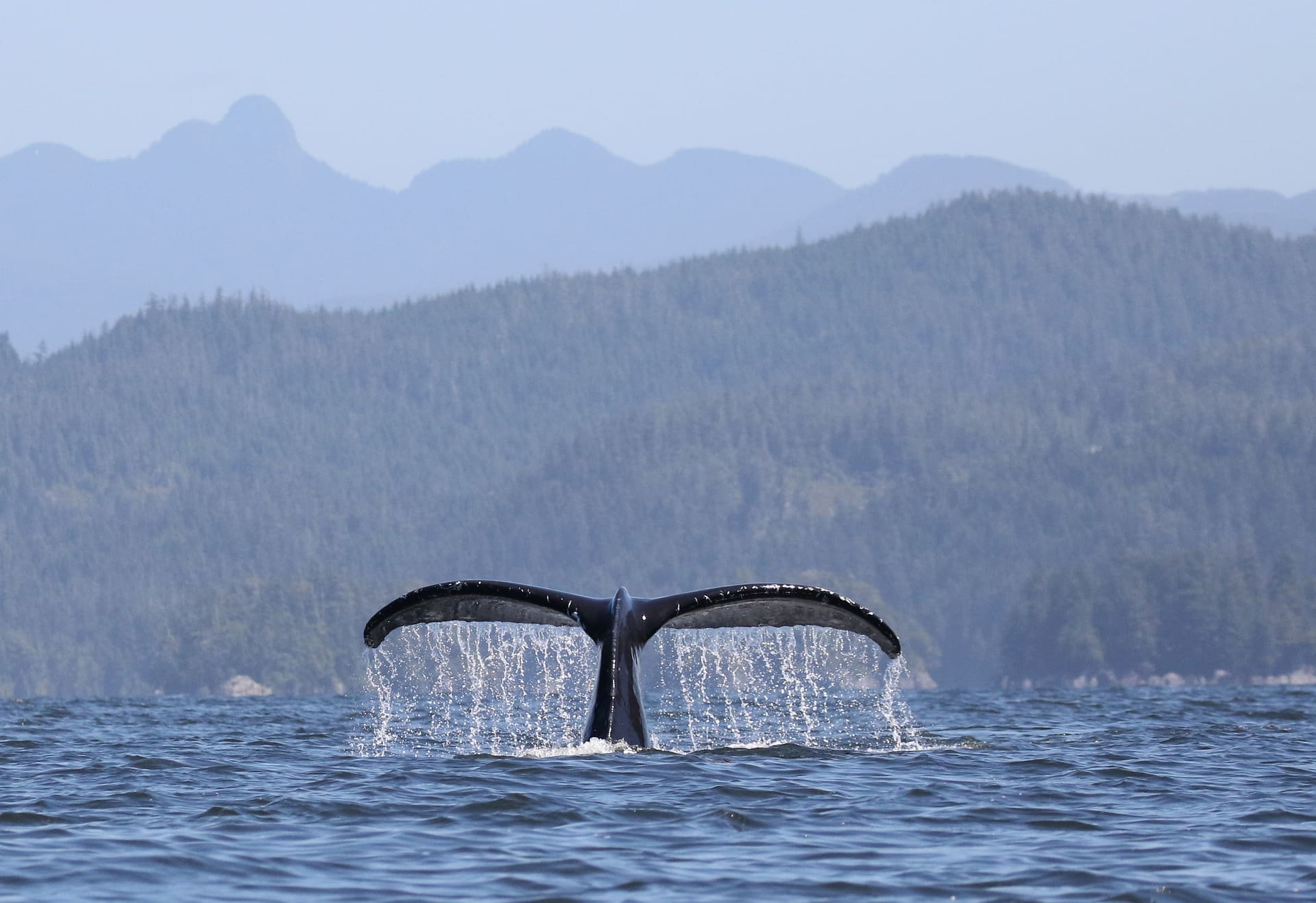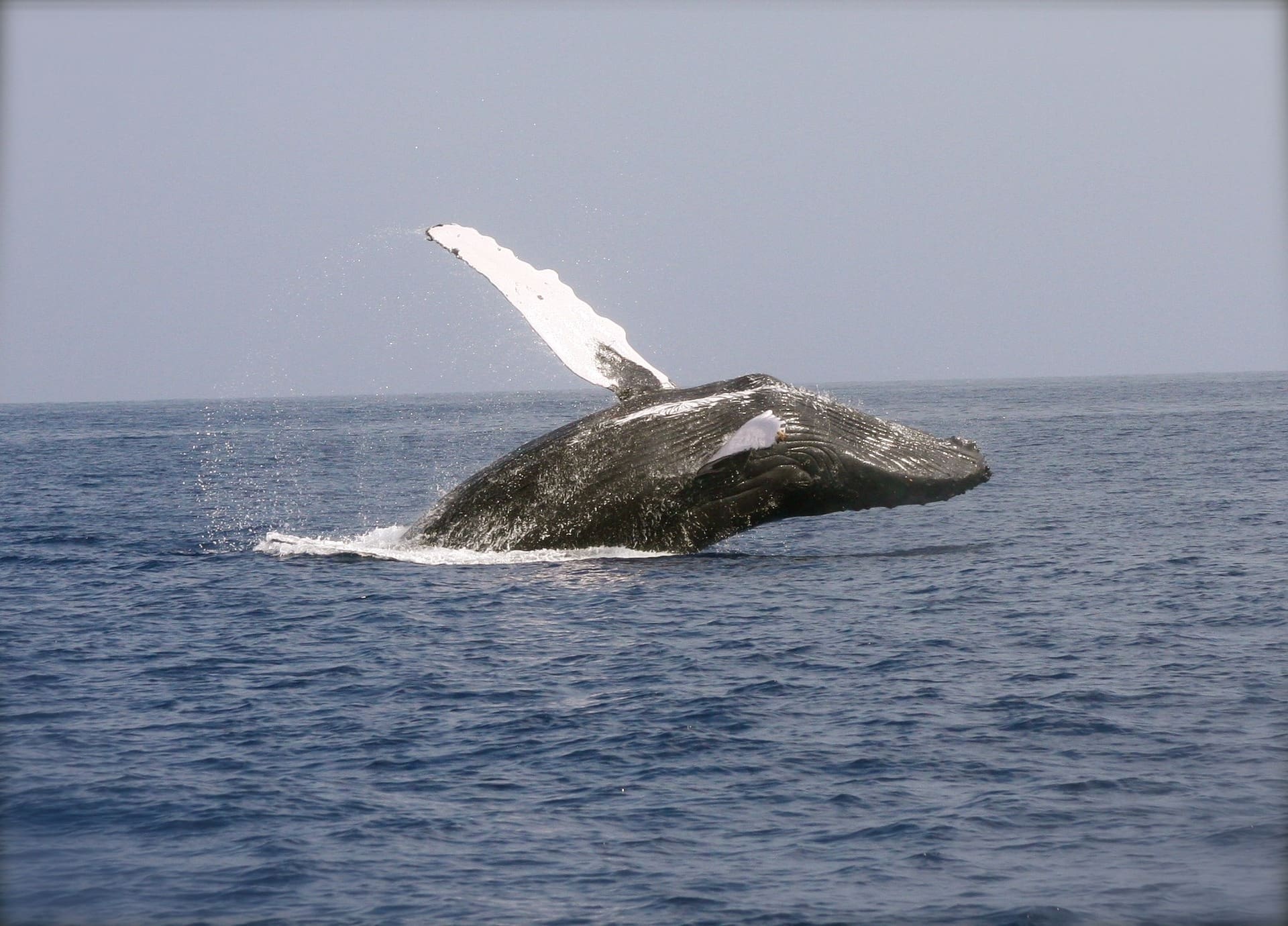What species of tremendous size and grace undertakes the largest mammal migration on Earth?
The humpback whale!

In the vast expanses of the world’s oceans, a symphony of moans, cries, and howls fills the water, echoing across great distances. This stunning serenade is the song of the humpback whale, one of the most majestic creatures to grace the seas.
Scientifically known as Megaptera novaeangliae, the humpback whale derives its common name from the distinctive hump on its back. With dark backs, light bellies, and long pectoral fins that resemble wings, these whales are a sight to behold. Their Latin name, signifying “big wing of New England,” pays homage to those impressive pectoral fins and early encounters European whalers had with these graceful giants off the coast of New England.

Humpback whales are renowned for their enchanting songs, which echo through the ocean depths for great distances. These compositions, which consist of moans, howls, and cries, are among the longest and most complex in the animal kingdom. Scientists speculate that these melodic masterpieces serve as a means of communication and courtship, with male humpbacks serenading potential mates during the breeding season for minutes to hours at a time. Songs have also been observed during coastal migrations and hunts. Many artists have taken inspiration from these songs, and you can even listen to eight-hour mixes of them to help you get to sleep. Check it out:
Another marvel of the humpback are their awe-inspiring displays of acrobatics, from flipper slapping to full-body breaching. Despite their colossal size, these creatures display remarkable agility and grace. With lengths of up to 62.5 feet (19m, or one school bus!) and weights of 40 tons (40,000 kg), humpback whales are true behemoths of the ocean.
Life on the move
Life for a humpback whale is a tale of two halves—a perpetual journey between polar feeding grounds and tropical breeding waters. These remarkable migrations span thousands of miles and rank as one of the longest animal migrations on the planet, and the longest among mammals.
Feasting on plankton, krill, and small schooling fish, humpback whales are skilled hunters, capable of consuming up to 1,360 kilograms of food per day. Employing innovative techniques such as bubble-netting and kick-feeding, they ensnare their prey with precision and efficiency. Generally these whales stay in small and dynamic groups, and they use their social intelligence and coordination to orchestrate these group hunting mechanisms.
Ecological powerhouses
Humpback whales’ feeding and movement contributes to more than just their own wellbeing. As these majestic creatures feed on zooplankton, copepods, and other food sources in the oceans’ depths, and subsequently ascend to the surface, they disrupt the thermocline—a boundary between surface and deep waters—facilitating greater mixing of ocean layers. This enhanced mixing fosters increased nutrient availability, benefiting a myriad of marine organisms.
They also cycle nutrients through their own consumption and excretion, contributing to a phenomenon known as the “biological pump.” These whales ingest biomass and nutrients from microscopic and small macroscopic organisms in deeper waters, digest it, and excrete their own waste in large macroscopic fecal plumes on the ocean’s surface. This cyclical process effectively transports nutrients from the ocean depths back to the surface, replenishing vital elements such as nitrogen for algae and phytoplankton growth. In regions like the Gulf of Maine, the nitrogen influx from whale feces surpasses that of all nearby rivers combined, underscoring the profound impact of these marine giants on nutrient cycling. Finally, when a whale’s life has come to an end, its own massive body sinks to the ocean floor and countless organisms are nourished by it in the decomposition process.

Conservation and Resurgence
Understanding the multifaceted lives and roles of humpback whales underscores the urgency of their conservation. Historically valued solely for commercial exploitation, these majestic creatures now emerge as essential components of oceanic ecosystems. Though humpback whales have faced centuries of exploitation and habitat degradation, concerted conservation efforts offer hope for their survival, not only safeguarding whales themselves but also preserving the intricate ecological processes that sustain marine life and biodiversity.
Whales continue to face threats from ship collisions, entanglement in fishing gear, noise pollution, and the disruption of habitat for their food sources due to trawling, pollution, and encroachment. But strong advocacy has brought these creatures back from the brink before, and our conservation and restoration work can safeguard the future of these enchanting giants and ensure that their songs continue to echo through the seas for generations to come.
Take a look at Sir David Attenborough’s tale of their resurgence and beauty:
May we steward the ocean with love and care,
Maya

Maya Dutta is an environmental advocate and ecosystem restorer working to spread understanding on the key role of biodiversity in shaping the climate and the water, carbon, nutrient and energy cycles we rely on. She is passionate about climate change adaptation and mitigation and the ways that community-led ecosystem restoration can fight global climate change while improving the livelihood and equity of human communities. Having grown up in New York City and lived in cities all her life, Maya is interested in creating more natural infrastructure, biodiversity, and access to nature and ecological connection in urban areas.
Sources and Further Reading:
https://www.fisheries.noaa.gov/species/humpback-whale
https://www.nationalgeographic.com/animals/mammals/facts/humpback-whale
https://www.nwf.org/Educational-Resources/Wildlife-Guide/Mammals/Humpback-Whale
https://us.whales.org/whales-dolphins/species-guide/humpback-whale/
https://www.pbs.org/wnet/nature/blog/humpback-whale-fact-sheet/
https://conservationconnections.blogspot.com/2012/05/importance-of-whale-poop-interview-with.html
https://www.youtube.com/watch?v=uRY9giOUTrI (Whales as Keystone Species – Cycling Nutrients, Carbon and Heat with Joe Roman at Bio4Climate’s Restoring Oceans conference)


